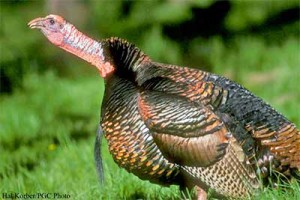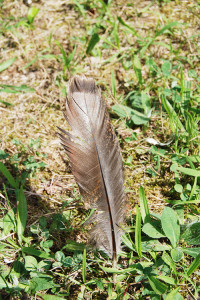On this overcast August day during an open house in Durham PA a family of Turkeys in Upper Bucks County PA decided to stop by for a visit. We weren’t sure of their home purchasing status, since they roost in trees at night and wander daily in search of food. There were a two hens and nine little turkeys that appeared to be grazing on different things. So we started wondering…
What are baby turkeys called?
Baby turkeys are called poults and a group of turkeys is called a flock.
Learn More About Wild Turkeys at About.com
How old were these juvenile turkeys?
When mating season arrives, anywhere from February to April, courtship usually begins while turkeys are still flocked together in wintering areas. After mating, the hens begin searching for a nest site and laying eggs. In most areas, nests can be found in a shallow dirt depression, surrounded by moderately woody vegetation that conceals the nest. Hens lay a clutch of 10 to 12 eggs during a two-week period, usually laying one egg per day. She will incubate her eggs for about 28 days, occasionally turning and rearranging them until they are ready to hatch.
Learn more about Wild Turkeys at NWTF
What were these turkeys eating?
Turkeys are omnivorous and consume a wide range of food stuffs depending on season and food availability. In the spring they eat plant shoots, buds, insects, tubers, and any overwintering mast (acorns etc). In the summer they consume vegetation and many large insects (especially grasshoppers and beetles), other invertebrates (snails, slugs, spiders, ticks, and centipedes), and many small vertebrates (including salamanders, frogs, lizards, and even small snakes). In the fall they eat the newly fallen mast, fruit, and seeds and also waste grain from agricultural fields. Mast is especially important to turkeys, and good mast production years almost always lead to a surge in their populations.
Learn more about Wild Turkeys at the Penn State web site
Are there a lot of turkeys in Pennsylvania?
In a wild turkey population trend analysis published in January 2014, turkey numbers peaked in 2001 at about 275,000, and by 2009 had dropped to a new normal of around 175,000.
Learn More About Wild Turkeys at the P0st-Gazette
The Wild Life in Bucks County PA
In addition to wild turkeys, living in Upper Bucks County PA you’ll see deer, fox, raccoons, ducks and an occasional bear.
Enjoy your Upper Bucks County Home, and if you’re in search of a place to live in Bucks County please contact us. Happy Summer Nights!




No comments yet.